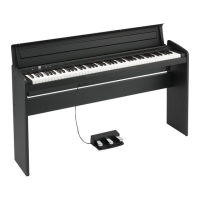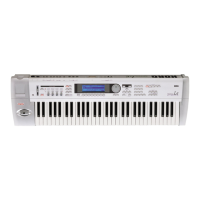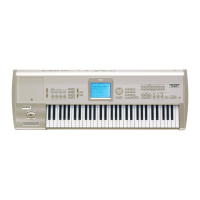Program mode
52
• You can set an initial positive amount with the Intensity
to A/B parameters, and then reduce this amount with
velocity. In this case, the final effect of the EG is simply
diminished, and not actually inverted, as shown in
example C above.
• You can also set the Velocity to A/B amounts so that
they are greater than the initial amounts of Intensity to
A/B. In this case, the EG will have a positive effect at
low velocities, and an inverted effect at high velocities–
as shown in example D.
Velocity to B [–99...+99]
This lets you use velocity to scale the amount of the Filter
EG applied to Filter B. For more information, please see
“Velocity to A,” above.
Intensity to A [–99...+99]
This controls the initial effect of the Filter EG on Filter A’s
cutoff frequency, before any velocity or AMS modulation.
The Filter EG’s shape can swing all the way from +99 to –99.
Positive values increase the cutoff frequency, and negative
values decrease the cutoff frequency. For instance, please see
the graphic “Velocity control of Filter EG,” above. The EG
shape in example A rises up at first, and then falls below 0
towards the end.
When Intensity to A is set to a positive (+) value, EG’s effect
will match its shape. When the EG rises above 0, the cutoff
frequency will increase.
With negative (–) values, the effect will be in the opposite
direction; when the EG rises above 0, the filter cutoff will
decrease.
Intensity to B [–99...+99]
This controls the initial effect of the Filter EG on Filter B’s
cutoff frequency, before any velocity or AMS modulation.
For more information, please see “Intensity to A,” above.
AMS (Filter EG AMS) [List of AMS Sources]
This selects any AMS modulation source to scale the amount
of the Filter EG applied to Filters A and B. The two filters
share a single AMS source, with separate intensity settings.
Otherwise, the AMS modulation will work in the same way
as the Velocity to A parameter, described above.
For a list of AMS sources, please see “AMS (Alternate
Modulation Source) List” on page 588.
Int to A (AMS Intensity to A) [–99...+99]
This controls the depth and direction of the EG AMS
modulation for Filter A.
Int to B (AMS Intensity to B) [–99...+99]
This controls the depth and direction of the EG AMS
modulation for Filter B.
3–1–3b:Filter A/B Modulation
This section lets you assign any two AMS sources to control
Filter A, and another two AMS sources to control Filter B.
This modulation is added to the basic Filter A and B cutoff
frequencies, as set on the Filter 1 page.
Filter A
AMS1 (Filter A AMS1) [List of AMS Sources]
This selects the first modulation source for controlling Filter
A’s cutoff frequency. For a list of AMS sources, please see
“AMS (Alternate Modulation Source) List” on page 588.
Intensity (AMS1 Intensity) [–99...+99]
This controls the depth and direction of AMS1.
AMS2 (Filter A AMS2) [List of AMS Sources]
This selects the second modulation source for controlling
Filter A’s cutoff frequency. For a list of AMS sources, please
see “AMS (Alternate Modulation Source) List” on page 588.
Intensity (AMS2 Intensity) [–99...+99]
This controls the depth and direction of AMS2.
Filter B
The parameters for Filter B are identical to those for Filter A.
For more information, please see the descriptions under
Filter A, above.
▼3–1–3: Menu Command
• 0: Write Program ☞p.106
• 1: Panel–SW Solo Mode On ☞p.106
• 2: Exclusive Solo ☞p.107
• 3: Copy Oscillator ☞p.111
• 4: Swap Oscillator ☞p.111
For more information, please see “Program: Menu
Command” on page 106.

